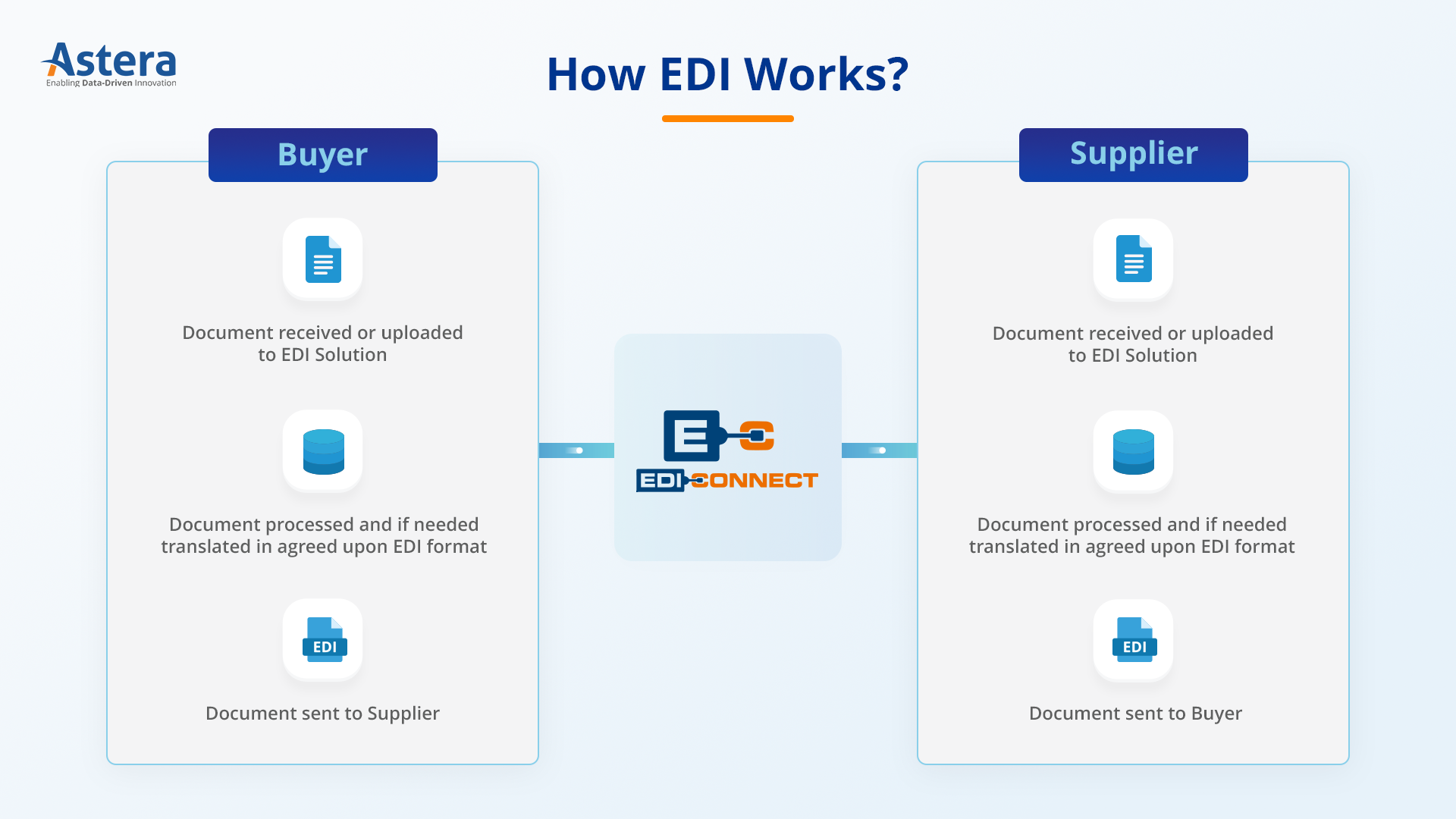
EDI Tools: A Comprehensive Guide
What are EDI Tools?
Today, seamless integration and efficient data exchange drive business success across industries. Electronic Data Interchange (EDI) is one of the fastest and most reliable channels businesses use for B2B communication. These businesses rely on various EDI tools and solutions to simplify their data exchange processes.
EDI tools are powerful software applications designed to automate and facilitate the exchange of structured business documents between systems, organizations, or trading partners. These documents frequently include purchase orders (PO), invoices, shipping documents, healthcare claims, etc.

EDI Tools: Streamlining B2B Data Exchange
These tools streamline the entire data exchange process by ensuring compatibility and consistency in data formats. Modern EDI solutions are efficient, accurate and offer secure EDI integration, eliminating manual processes and, at the same time, enabling you to remain EDI compliant.
Types of EDI Tools
EDI tools come in various forms, each specifically designed to address different aspects of electronic data interchange and cater to unique business requirements. These tools streamline data exchange and improve integration efficiency and collaboration with trading partners. Here are the most common types of EDI tools you can find:
- EDI Translation Software: EDI translators offer a user-friendly interface to transform and map data. They allow you to convert data from your internal systems into standardized EDI formats that your trading partners support.
- Communication Gateways: These are communication-focused tools that establish secure connections using protocols like FTP, AS2, or SFTP. Communication gateways also handle the encryption and decryption of data, provide authentication mechanisms, and enable error detection and recovery.
- Trading Partner Management Tools: These tools simplify managing trading partner relationships. They provide a centralized platform where you can onboard new trading partners, configure their specific EDI requirements, and establish communication channels. You can also leverage features like partner profile management to store and maintain information about each trading partner.
While each of these tools can do their jobs sufficiently well, they cannot handle the EDI process from end to end. For this reason, businesses look toward full-fledged EDI tools or platforms with comprehensive features.
The Need for a Unified EDI Tool
Now, let’s discuss why a unified EDI tool is essential for your integration efforts. A unified EDI solution consolidates different functionalities into a single comprehensive solution. It’s your secret weapon to achieving operational excellence.
Here are some more reasons why you should opt for a comprehensive EDI solution:
Simplified Integration
First off, a unified EDI tool simplifies your integration efforts. You no longer have to use multiple standalone tools to use various aspects of EDI. Instead, everything you need is consolidated into one comprehensive solution. It’s like having all your integration superpowers in a single tool, saving you time, effort, and resources.
You should also think about the complexity that arises when you’re managing multiple tools. Each one has its own configuration, interface, and learning curve. But with unified EDI software, you can bid farewell to that chaos. You’ll have all the necessary features and capabilities neatly organized in one place, like a centralized control center for your integration operations.
Holistic View
One of the most significant advantages of a unified EDI tool is the holistic view it provides. Picture yourself overlooking your entire data exchange process from a single dashboard. You can monitor data flows, track transactions, and quickly identify hiccups or bottlenecks. This bird’s-eye view of your integration landscape empowers you to take prompt actions and optimize your processes for better efficiency.
Seamless Coordination
With all the components of your EDI operations seamlessly coordinated within a unified tool, you can achieve smoother data flows and improved synchronization with your trading partners. You no longer have to worry about data discrepancies or misinterpretations during document exchange.
Faster Business Cycles
The benefits of a unified EDI tool extend beyond streamlined processes. They directly impact your business cycles, from procurement and production to order fulfillment and customer service. By consolidating your EDI functionalities, you speed up document exchange and enhance communication with your trading partners. This means improved supply chain efficiency, faster order processing, and, ultimately, happier customers.
Put concisely, a unified EDI tool is like having a trusted companion that simplifies your integration efforts.
Factors to Look for in a Comprehensive EDI Solution
When selecting an EDI tool for your business, it’s crucial to take a comprehensive approach and consider a range of factors to ensure you make the right choice. It’s not just about ticking off a checklist of features; it’s about finding the right EDI solution that aligns with your business needs and objectives. In this pursuit, you should take the following factors into account:
Automation
Automated data exchange between your trading partners enables you to free up resources that you can allocate to more value-added tasks within your organization. It also streamlines the exchange of EDI documents. For example, the tool can automatically route purchase orders to the appropriate departments for review and approval, trigger order fulfillment processes, and generate acknowledgments or invoices.
Additionally, by leveraging EDI automation, you can also reduce labor costs associated with data entry, document handling, and error correction.
Compliance and Standards
Your trading partners may have their own preferred EDI standards and document formats. You may also be regularly onboarding new trading partners who use different EDI standards or document types. Therefore, compliance with industry-specific regulations and EDI standards should be the top priority for you and your trading partners.
Ensure the solution adheres to all regulations and supports relevant EDI standards like EDIFACT, X12, or XML. For example, healthcare organizations must comply with HIPAA (Health Insurance Portability and Accountability Act) regulations, while retail businesses may need to adhere to GS1 standards.
Read more: differences between EDIFACT and X12
Scalability
A scalable EDI tool ensures that you can expand your operations without facing limitations or disruptions. As your business grows, your integration requirements will change. For that, you need a solution that can quickly adapt to accommodate increased transaction volumes, additional trading partners, and evolving business processes without sacrificing performance or experiencing delays.
Moreover, salability is a long-term consideration when choosing an EDI tool. It ensures that the selected tool can scale as needed without frequent system upgrades or replacements.
Data Mapping and Transformation
When it comes to data mapping and transformation, always look for a solution that offers a user-friendly interface and support for various data formats and standards. The interface should be intuitive and easy to navigate, allowing users to configure mapping rules without requiring extensive technical knowledge or coding skills. This flexibility enables your teams to integrate systems seamlessly.
The EDI tool should also provide robust support for data transformations. Ensure that it offers a comprehensive set of transformation functions, such as date formatting, conditional logic, and data enrichment through lookups or database operations.
Communication Protocols
Your EDI tool should support a wide range of secure communication protocols so that you can accommodate all your trading partners. These protocols are essential for establishing reliable connections with them and ensuring the secure exchange of business documents. Some of these protocols include:
- AS2 (Applicability Statement 2) and AS4
- FTP (File Transfer Protocol) and SFTP
- HTTP and HTTPS
Error Handling and Validation
EDI tools utilize validation rules to verify the correctness of data in EDI transactions. These rules can include checks for data type, length, format, mandatory/optional fields, and adherence to specific business rules or industry standards. The tool compares the data in the transaction against these rules to identify any violations or errors.
Specific error handling and validation functionalities can vary across different EDI tools greatly. The level of customization also varies based on the tool’s features. Ensure that the EDI tool you choose has robust error handling and validation mechanisms in place. These mechanisms should be able to identify various types of errors and, subsequently, notify you to take necessary actions promptly.
Astera EDIConnect: A Comprehensive EDI Solution for Modern Businesses
Modern organizations conduct business at a rapid pace, driven by advancements in technology and the demand for instant, reliable connectivity. Astera EDIConnect offers a complete EDI solution fueled by automation. It streamlines the entire B2B data exchange process with its powerful integration engine and intuitive UI.
Here are more reasons to consider EDIConnect:
- Intuitive User Interface: Our EDI tool offers an intuitive and user-friendly interface that allows for drag-and-drop visual mapping. This makes handling complex hierarchical structures like EDI and XML seamless and straightforward.
- Automation and Process Orchestration: Easily define process orchestration for both incoming and outgoing EDI files. With this functionality, you can automate tasks such as file download/upload, generating acknowledgements, invoking data maps, and sending emails.
- Translation Capability: Leverage the built-in high-performance EDI translator to efficiently process data volumes of any size, ensuring optimal performance and scalability.
- Validation Functionality: The integrated validator seamlessly performs standard and custom validations, ensuring data integrity and compliance with EDI standards.
- Simplified Transaction Building: EDIConnect’s transaction builder simplifies the process of building complex hierarchical EDI transactions, even for business users.
- Repository Manager: It includes a built-in repository manager, providing a comprehensive library of pre-defined templates for various business transactions.
- Efficient Partner Management: The partner manager component allows you to define and manage EDI partner information.
Now that you’re equipped with a deeper understanding of EDI tools and their importance for seamless integration, it’s time to see how Astera EDIConnect simplifies document exchange. Sign up for a free demo or call +1 888-77-ASTERA and we’ll have one of our solution experts on the line to assist you with your use case.
 Astera AI Agent Builder - First Look Coming Soon!
Astera AI Agent Builder - First Look Coming Soon!



